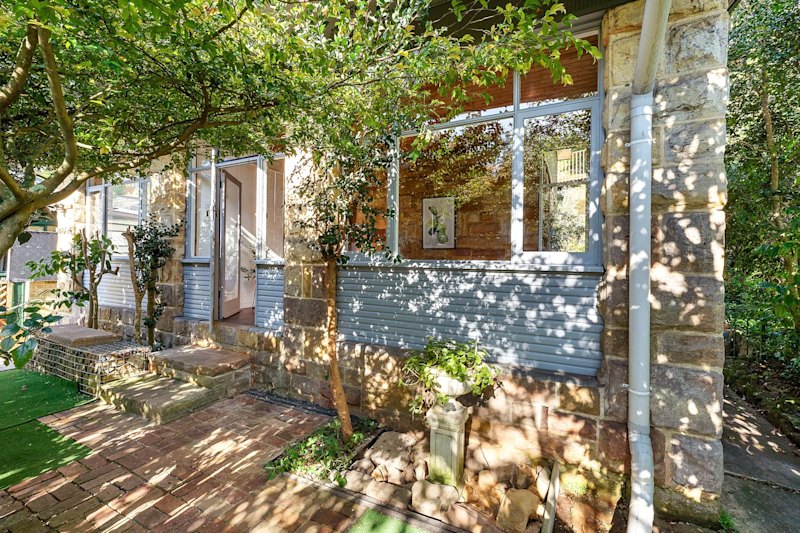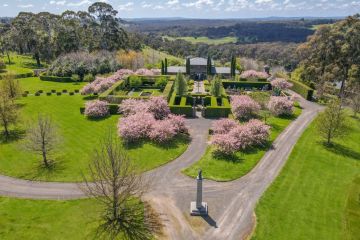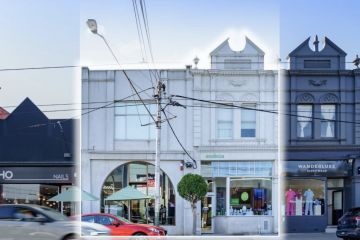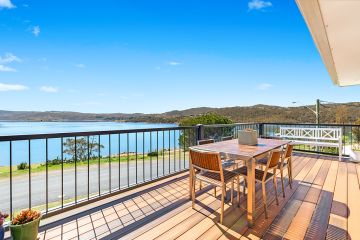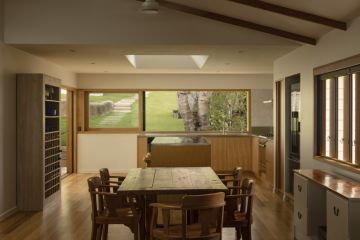Buyers seek out inner-city shops
Buyers are taking advantage of the dwindling retail sector by converting former shops into family homes.
Often in sought-after locations close to cafes, public transport and major roads, commercial spaces hold huge potential for buyers willing to convert the properties into homes.
Karlee Sangster, Oliver Hextall and their son live above a shop on Melbourne’s bustling Sydney Road.
“We didn’t want to live in a shop, we wanted to live in that shop,” Sangster says.
“It appealed because of the charm of the building, the unrenovated inside and out and the location.”

Matthew Conway’s home, at 217 Elizabeth Street, Coburg North, Victoria. Photo: Paul Cadenhead
Undeterred by the 15-year commercial lease (they persuaded friends to move their record store into the space underneath), street noise and shared downstairs bathroom, the couple have transformed the space into a warm, inviting home.
Choosing to embrace the shop’s features, the main changes have been a paint job, added shelves, new curtains and plenty of indoor plants.
The “New Moon Cafe” sign has been left in its place and is a prominent feature of the exterior.

The shop layout at Matthew Conway’s home. Photo: Paul Cadenhead
“‘Home’ is a pretty abstract concept, and we are the kind of people that loved the space as it was, so we have no desire to change it into something it’s not,” Sangster says.
“As long as it’s clean and safe for our 16-month-old, it works.”
In neighbouring Coburg, Matthew Conway and his partner Louisa have transformed a former shop front into a residence and part-time bar.

The living area at Matthew Conway’s home. Photo: Paul Cadenhead
“The commercial zoning of the property meant that it was cheaper than a residential property with the same floor space,” Conway says.
“At first we just wanted to convert what was the cafe into an open plan kitchen and living area … but we were curious about how a little neighbourhood bar might go, so we decided to set it up and open on the weekends [hence the bar’s name, Sometimes].”
Converting the space called for ambient noise monitoring plus security and waste management (all required under council regulations) and adding blinds to the front windows to ensure the space was comfortable for both the family and their customers.
.jpg)
Bedroom at Matthew Conway’s home: Photo: Paul Cadenhead
“This mitigates any light pollution and also helps with the acoustics, as do the tiles on the ceiling,” Conway says.
“At the rear, we refitted the kitchen and installed bi-fold doors that open out onto the courtyard.”
With a young daughter, creating a separation between the bar and residence was also important.

Matthew Conway’s backyard courtyard. Photo: Paul Cadenhead
“There’s a storeroom and downstairs hall that separates the venue from the home when we are open, which keeps it quiet in the home area so our daughter can sleep,” Conway says.
With another baby on the way, the couple are looking for new owners to take over the now home and bar as they focus on family life.
Interior designer Sibella Court has recently placed her converted shop residence on the market.
The Victorian-era shopfront was the launching pad for her business The Society Inc (which has since moved to St Peters), with Court’s home occupying the two rooms above.
 Sibella Court’s home at 27 Alexander Street, Paddington.
Sibella Court’s home at 27 Alexander Street, Paddington.
“My beautiful old corner store from the 1860s is in the depths of residential leafy Paddington; it is peaceful and quiet with a beautiful community,” Court says.
The home retains many of the shop’s original features, combined with Court’s signature eclectic style.
“The front windows I love, and instead of trying to shut out the inside and close off the light, I attached brass curtain rails halfway down and sewed vintage Belgium linen curtains that can be shut or opened depending on my mood.”

The pot belly stove in the Sibella Court’s home.
Many of her furnishings also double as storage, which is often limited in commercial spaces.
“I have many collections and have always loved storage. I like to display my things rather than hide them away,” Court says.
“I bought a huge old cupboard (it took six men to move) from a pencil factory in Egypt from the 1900s.”
Court’s work hosting ABC program Restoration Australia has inspired her to sink her teeth into a larger project.
“Any space can be your home as long as it has the people and things you love in it,” she says.

A single bedroom in Sibella Court’s home.
Kelly Cloake and Aedan Howlett, co-owners of the Alabama Hotel, didn’t picture a shop when they started searching for a home, but have happily lived above one in Hobart’s CBD for seven years.
“House hunting at the time, high on our list was a garden to grow vegies in and a nice little cottage that needed fixing,” Cloake says.
“We found the 1920s apartment above shops in the middle of the CBD after it had been passed in at auction. It was a dump, but had soaring ceilings and was massive.”
.jpeg)
Shelving storage in Sibella Court’s home.
The sound of the pedestrian crosswalk on the street below may permeate their dreams, but it’s a small price to pay for the private and secure inner-city home.
The biggest changes they have made to the space since buying have been adding more storage and redoing the bathroom and kitchen.
“When we moved in, the place had been a rental for decades it seemed,” Cloake says.
“Aedan [who is also an artist, furniture maker and builder] is super-handy and has done all the work apart from plumbing and electrical himself.”

The upstairs terrace in Sibella Court’s home.
The couple enjoy the sense of community living in the CBD provides.
“One of the shops below us is run by a good friend of ours so it is always nice to walk past and say hello,” Cloake says.
“In fact, we know most of the shop owners on the street; there is a great inner-city community here.”

Another single bedroom, upstairs in a Sibella Court home.
Find your own converted shop on Domain:
We recommend
We thought you might like
States
Capital Cities
Capital Cities - Rentals
Popular Areas
Allhomes
More
